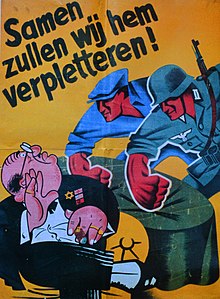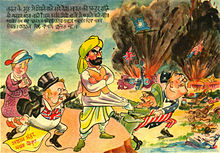
Why We Fight is a series of seven propaganda films produced by the US Department of War from 1942 to 1945, during World War II. It was originally written for American soldiers to help them understand why the United States was involved in the war, but US President Franklin Roosevelt ordered distribution for public viewing.

The Quit India Movement was a movement launched at the Bombay session of the All India Congress Committee by Mahatma Gandhi on 8 August 1942, during World War II, demanding an end to British rule in India.

The United States Office of War Information (OWI) was a United States government agency created during World War II. The OWI operated from June 1942 until September 1945. Through radio broadcasts, newspapers, posters, photographs, films and other forms of media, the OWI was the connection between the battlefront and civilian communities. The office also established several overseas branches, which launched a large-scale information and propaganda campaign abroad. From 1942 to 1945, the OWI revised or discarded any film scripts reviewed by them that portrayed the United States in a negative light, including anti-war material.

The New Order of Europe was the political and social system that Nazi Germany wanted to impose on the areas of Europe that it conquered and occupied.

Richard Conrad Lukas is an American historian and author of books and articles on military, diplomatic, Polish, and Polish-American history. He specializes in the history of Poland during World War II.
The Nazi Party of Germany adopted and developed several pseudoscientific racial classifications as part of its ideology (Nazism) in order to justify the genocide of groups of people which it deemed racially inferior. The Nazis considered the putative "Aryan race" a superior "master race", and they considered black people, mixed-race people, Slavs, Roma, Jews and other ethnicities racially inferior "sub-humans", whose members were only suitable for slave labor and extermination. These beliefs stemmed from a mixture of 19th-century anthropology, scientific racism, and anti-Semitism. The term "Aryan" belongs in general to the discourses of Volk.
Jewish Bolshevism, also Judeo–Bolshevism, is an antisemitic conspiracy theory that claims that the Russian Revolution of 1917 was a Jewish plot and that Jews controlled the Soviet Union and international communist movements, often in furtherance of a plan to destroy Western civilization. It was one of the main Nazi beliefs that served as an ideological justification for the German invasion of the Soviet Union and the Holocaust.

During American involvement in World War II (1941–45), propaganda was used to increase support for the war and commitment to an Allied victory. Using a vast array of media, propagandists instigated hatred for the enemy and support for America's allies, urged greater public effort for war production and victory gardens, persuaded people to save some of their material so that more material could be used for the war effort, and sold war bonds.

The Russian Fascist Party (RFP), sometimes called the All-Russian Fascist Party, was a minor Russian émigré movement that was based in Manchukuo during the 1930s and 1940s.
The Hindu–German Conspiracy failed to engage popular support within India. However, it had a significant impact on Britain's policies both in the empire, as well as on her international relations. The outlines and plans for the nascent ideas of the conspiracy were noted and began to be tracked by the British intelligence as early as 1911. Alarmed at the agile organisation, which repeatedly reformed at different parts of the country despite being subdued in others, the chief of Indian Intelligence Sir Charles Cleveland was forced to warn that the idea and attempt at pan-Indian revolutions were spreading through India "like some hidden fire". A massive, concerted and coordinated effort was required to subdue the movement. Attempts were made in 1914 to prevent the naturalisation of Tarak Nath Das as an American citizen, while successful pressure was applied to have Har Dayal interned. The conspiracy had been detected early by British intelligence, and had been the subject of strong British pressure from 1914.

Merle Fainsod was an American political scientist best known for his work on public administration and as a scholar of the Soviet Union. His books Smolensk under Soviet Rule, based on documents captured by the German Army during World War II, and How Russia is Ruled helped form the basis of American study of the Soviet Union, and established him "as a leading political scientist of the Soviet Union." Fainsod is also remembered for his work in the Office of Price Administration and as the director of the Harvard University Library.

The Soviet offensive plans controversy was a debate among historians in the late 20th and early 21st centuries as to whether Joseph Stalin had planned to launch an attack against Nazi Germany in the summer of 1941. The controversy started with Viktor Suvorov with his 1980s book Icebreaker:Who started the Second World War? where he argued, based on his analysis of historical documents and data, that Stalin used Nazi Germany as a proxy to attack Europe.

Throughout World War II, both the Axis and Allied sides used propaganda to sway the opinions of Indian civilians and troops, while at the same time Indian nationalists applied propaganda both within and outside India to promote the cause of Indian independence.

During World War II, the Barbarossa decree was one of the Wehrmacht criminal orders given on 13 May 1941, shortly before Operation Barbarossa, the invasion of the Soviet Union. The decree was laid out by Adolf Hitler during a high-level meeting with military officials on March 30, 1941, where he declared that the upcoming war against the Soviets would be a war of extermination, in which both the political and intellectual elites of Russia would be eradicated by German forces, in order to ensure a long-lasting German victory. Hitler underlined that executions would not be a matter for military courts, but for the organised action of the military. The decree, issued by Field Marshal Keitel a few weeks before Operation Barbarossa, exempted punishable offenses committed by enemy civilians from the jurisdiction of military justice. Suspects were to be brought before an officer who would decide if they were to be shot. Prosecution of offenses against civilians by members of the Wehrmacht was decreed to be "not required" unless necessary for the maintenance of discipline.
This is a select bibliography of post World War II English language books and journal articles about the Revolutionary and Civil War era of Russian (Soviet) history. The sections "General Surveys" and "Biographies" contain books; other sections contain both books and journal articles. Book entries may have references to reviews published in English language academic journals or major newspapers when these could be considered helpful. Additional bibliographies can be found in many of the book-length works listed below; see Further Reading for several book and chapter length bibliographies. The External Links section contains entries for publicly available select bibliographies from universities.
This is a select bibliography of post World War II English language books and journal articles about Stalinism and the Stalinist era of Soviet history. Book entries have references to journal reviews about them when helpful and available. Additional bibliographies can be found in many of the book-length works listed below.
This is a select bibliography of English language books and journal articles about the post-Stalinist era of Soviet history. A brief selection of English translations of primary sources is included. The sections "General Surveys" and "Biographies" contain books; other sections contain both books and journal articles. Book entries have references to journal articles and reviews about them when helpful. Additional bibliographies can be found in many of the book-length works listed below; see Further Reading for several book and chapter-length bibliographies. The External Links section contains entries for publicly available select bibliographies from universities.
This is a select bibliography of English language books and journal articles about the Soviet Union during the Second World War, the period leading up to the war, and the immediate aftermath. For works on Stalinism and the history of the Soviet Union during the Stalin era, please see Bibliography of Stalinism and the Soviet Union. Book entries may have references to reviews published in English language academic journals or major newspapers when these could be considered helpful.

This is a select bibliography of English-language books and journal articles about the history of Ukraine. Book entries have references to journal reviews about them when helpful and available. Additional bibliographies can be found in many of the book-length works listed below. See the bibliography section for several additional book and chapter-length bibliographies from academic publishers and online bibliographies from historical associations and academic institutions.
This is a select bibliography of English language books and journal articles about the history of Poland during World War II. A brief selection of English translations of primary sources is included. Book entries have references to journal articles and reviews about them when helpful. Additional bibliographies can be found in many of the book-length works listed below; see Further Reading for several book and chapter-length bibliographies. The External Links section contains entries for publicly available select bibliographies from universities. This bibliography specifically excludes non-history related works and self-published books.






















